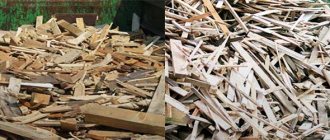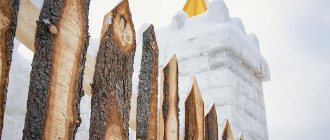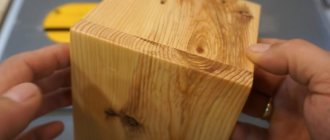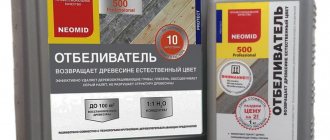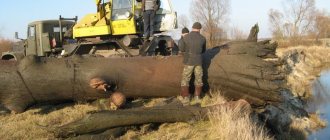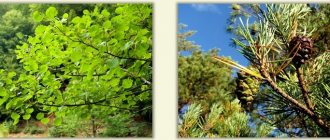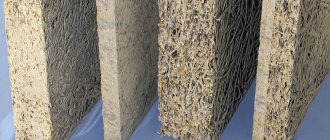It is difficult to name areas of life in which trees or products made from them would not be used.
Therefore, the question periodically arises - what to do with various plant and wood waste and products of the woodworking industry, how to get rid of them, because this material, being in an uncontrolled state, poses a serious danger.
In this article we will look at various ways of using or recycling wood and any waste from sawmilling and woodworking, you will find out what is made from wood and its waste, and we will also discuss issues related to them.
The need for recycling wood waste
Many environmental groups and concerned citizens are concerned about excessive deforestation. Sometimes felling turns into clear felling. The replacement of a forest landscape by a wasteland leads to a change in climate and groundwater levels, and forest animals and birds die.
At sawmills, from 20 to 50% of the forest turns into waste. Unused wood remains after logging. Some of the waste is burned on site, creating a fire hazard, while some of the scraps are left or taken to landfills. Whether wood waste rots in a landfill or at its source, the process uses up atmospheric oxygen, creates a mess, and is not beneficial.
By processing wood residues, you can obtain various useful products without cutting down trees. Removing branches from logging sites protects the forest from fires and the proliferation of pests.
Disposal methods
The remains that remain after wood processing are usually taken to country landfills or burned in furnaces. This method of disposal causes enormous harm to the environment and also requires large financial costs. Therefore, recently, owners of wood processing enterprises have begun to think about alternative methods of recycling raw materials that are used in Europe.
Wood residues are pressed to produce granulated and briquetted raw materials, which are then used in fuel boilers.
Pressing provides several advantages: it allows you to reduce waste volumes, reduces the costs of storing and transporting raw materials, and provides increased efficiency of combustion of the resulting fuel.
In addition to recycling, wood residues are widely used for processing and further production of various products. Recycling, compared to disposal, is a more complex process and brings good benefits to the entrepreneur.
Types of wood waste
Wood processing waste is divided into commercial and non-commercial wood. Croaker and lump cuttings are industrial wood. Small wooden products are made from such remains. The scope of application of commercial wood residues is wide. For some industries, it is more profitable to use waste rather than premium wood for the manufacture of small parts.
Non-commercial wood includes shavings, chips, knots, and small saw cuts. When processing such waste, you have to take into account the size and texture, and sometimes crush it until a uniform fraction is obtained.
For convenience, wood waste is divided into four categories. Industrial wood is waste of the first and partially second category.
First category
The first category includes slabs and under-slabs. A croaker is a cut of the edges of a log with bark. The second cut, necessary to transform the log into timber, forms the under-slab board.
Second category
The next category of wood waste includes log cuts, longitudinal and transverse trims, ends, carpentry residues, and plywood waste.
Third category
The third category includes the remains of veneer and wood building panels. Basically, waste of this group is generated during the repair process.
Fourth category
The last category includes tree bark, wood chips, sawdust, shavings and dust from sanding boards.
Types and volumes of waste use during logging
Occurrence and use of wood waste
Impressive volumes of wood processing waste accumulate during sawmilling. Approximately 60% of raw materials become the main product, the remaining 40% are waste. Among them are parts of boards, trimming areas with defects, slabs, slats, bark, and small fractions that appear after cutting.
Of the total wood waste, about 60-70% are secondary raw materials, while the rest are either recycled or thrown into landfills, thereby having a negative impact on the environment. Such statistics help to understand what explains the large amount of waste during wood processing, upon closer examination.
Interesting! A pressing issue now is the introduction and attempts to use resource-saving technology, including this applies to woodworking residues. At the moment, deforestation has not stopped, nor has the sale of wood in any volumes.
Law on mandatory recycling of wood waste
The government of the Russian Federation has long been working on a law on mandatory recycling of wood waste. Its adoption has been postponed until 2022. During this time, businesses dealing with wood processing residues must decide whether they will process the shavings and trimmings themselves or hand them over to third parties.
While only large enterprises are concerned with recycling waste, it is easier for small businesses to purchase commercial timber. Once the law is passed, all industrial wood residues will be benefited.
use of wood waste
Types of wood waste and their use
Many wood processing enterprises, after completing work, leave about 25–40% of waste wood material, the further fate of which is unknown. Since the conservation of forests is not only a problem for the country, but also for the whole world, standards for handling and sale must be introduced, the distribution of which would also affect wood waste.
According to existing statistics, Russia has the largest forest reserves in the world, their approximate area occupies more than 800 thousand hectares in the country, this figure is equal to approximately 25% of forest plantations of the entire planet.
Most of the forest plantations are located in the Far East and Siberia. The forest is a source of raw materials for all wood manufacturing or processing enterprises, but the forest is also considered a habitat for animals, birds and other mammals; without it, most of them will simply disappear. Entire populations of animals will die out, as we know, this can lead to a catastrophic outcome, which is why recycling wood waste and its use in production will not only preserve primary wood material, but also reduce wood waste, which will significantly reduce deforestation.
The forest is also a source of many types of berries, medicinal herbs and mushrooms, most of which are very useful not only for animals, but also for people; their disappearance can deprive the human body of necessary vitamins. And in some cases, even medicines made on an organic basis of forest herbs.
The existence of the problem of integrated use of wood processing residues began with the development of the sawmill industry. At that time, no one thought about the environmental problems that could arise due to the reduction of green spaces. Therefore, waste was simply destroyed by burning, so as not to occupy territory and not pose a threat to enterprises, as a highly flammable material.
Over the past period, woodworking technologies have been developing, automated control and other innovations have been introduced that make it possible to extract maximum profits, but the attitude towards waste has remained virtually unchanged. This mainly applies to small and medium-sized wood processing industries, which do not want to spend money on the development of processing and recycling technologies, so wood processing waste simply surrounds such companies.
Mechanical processing methods
The most popular is mechanical processing of wood waste. A variety of devices give waste materials a desired shape. When transporting, a container can hold more wood in the form of chips than in the form of branches.
Shredders
Rotary, drum or disk units crush substandard wood into chips. Loading of raw materials can be horizontal or vertical, the grinders themselves can be stationary or mobile.
Hammer crushers
Crushers crush any type of wood waste. Hammers attached to the rotor strike the waste to be disposed of at high speed. Even from powerful branches, only technological chips remain, suitable for further processing.
Crushing machines
These devices crush wood debris into small particles. Models of different capacities work with residues of different sizes. The size of the particles obtained at the output also varies. Crushed wood is used to produce fuel and building boards.
Furnaces
The easiest way to burn wooden remains is in ovens. This is cheaper than crushing, briquetting and only then burning. For waste of unstable configuration, cone-shaped furnace models are suitable. The resulting heat is used to heat rooms and heat water.
Waste from the wood processing industry
Category: Various non-food products
The process of processing and processing wood in all industries is associated with the production of large amounts of waste. Beginning
from the first stage - cutting of forests and removal of logs, and ending with the last stage - wood processing, the process is accompanied by the waste of part of the wood, which is not used in further production. The volume of waste is not only commensurate with the volume of resulting products, but often exceeds it. Thus, when cutting and removing wood from the forest, about 20% of the wood raw material consists of waste in the form of branches, stumps, roots, and about 20% of the removed wood is non-business wood (firewood). In sawmill production the amount of waste is 35-42%. In furniture production, the amount of waste on average is 53-65% of the received lumber. When producing plywood, waste amounts to 52-54%, and for sliced veneer - 30-45%. The annual amount of waste and non-commercial wood in the country is about 300 million m3.
Waste is a valuable secondary raw material for the production of a variety of materials, products, and products.
Waste classification. Wood waste can be classified according to types and stages of wood processing. By type, all waste is divided into solid: slabs, slats, trimmings, branches, tops, stumps, roots; soft: shavings, sawdust, wood dust, bark and bast; woody greens - needles, leaves. According to the stages of wood processing, waste is divided into waste associated with logging - branches, tops, stumps, roots, bark (partially), trimmings, non-business wood (dross); waste from primary wood processing in sawmilling, plywood production - slats, slabs, trimmings, shavings, sawdust, bark, flaw, pencil; secondary processing waste in furniture production - trimmings, shavings, sawdust.
Causes of waste. Waste is generated for the following reasons: due to the biological characteristics of tree growth (leaves, needles, branches, tops, stumps, roots, bark); due to the production of rectangular materials from round materials (slabs, slats); due to the camber of the trunk (slats, butt cuts); irregular shape of the trunk - ovality, cambered flaw); wood defects - knots, cracks (trimming); imperfections in the technological processes of wood processing (sawdust, shavings, trimmings, pencils, planing when planing veneer).
When processing and processing wood, in addition to waste, there are irrecoverable losses due to wood drying in all types of production (6%) and compression in the production of laminated laminated materials.
Use of waste. Wood waste, which is a secondary raw material, can partially or completely replace primary raw materials at enterprises producing particle boards and fiberboards, at woodworking enterprises, pulp and paper, wood chemical industries and in the production of building materials. The final products from waste can be obtained by mechanical processing, chemical, microbiological and energy-chemical processing.
Large lump waste can be used to produce small products, consumer goods, container boards, picket fences, plaster and roofing shingles, roofing tiles and shingles, household items, toys, simple furniture (hangers, shelves, stands, drawers, cabinets). Hundreds of different types of small products are made from lump waste.
All small lump waste in various industries can be processed into process chips, which are used as raw materials in pulp production, in the production of particle boards and fiberboards, in hydrolysis, chemical and other industries. Technological sawdust is used in hydrolysis and other industries.
Needles and leaves serve as valuable raw materials for the production of pine-vitamin flour, used as an additive to animal and fish feed, essential oils, pine medicinal extracts, chlorophyll-carotene paste, which is used as a medicinal product and for the manufacture of cosmetic products. Logging waste is used for processing into charcoal, used in metallurgical and other industries, and also as a raw material for processing into process chips. Wood shavings and sawdust are used for the production of various building materials, as well as raw materials for the chemical and hydrolysis industries.
In the production of building materials, wood waste is used to obtain many materials needed in the national economy.
Arbolite is a slab material made of cement or gypsum with wood filler in the form of chips. It is used in construction as a structural and thermal insulation material. The filler is crushed wood chips ranging in size from 2x2x0.5 mm to 20x5x5 mm. The density of heat-insulating wood concrete is 0.5-0.6 g/cm3, and that of structural and heat-insulating concrete is 0.65-0.7 g/cm3. Wood concrete is produced by casting into a mold (formwork).
Glass-wood panels are used as partition wall material. The panel consists of a wooden frame covered on both sides with fiberboard. Its middle is filled with glass-wood mass (chips and a binder - silicate paste). The density of the filler is 0.35-0.45 g/cm3.
Sawdust concrete is concrete for pouring into molds and formwork. In addition to sand, sawdust is added to its composition as a filler: ki. It is intended for the manufacture of walls (on formwork) for residential one-story houses, livestock farms, garages, sheds, and workshops. Its density is from 0.95 to 1.25 g/cm3.
Wood concrete is the same as sawdust concrete; It uses fine-grained gravel instead of sand as a mineral filler. Its density is 0.95-1.2 g/cm3.
Gypsum tile concrete - wall blocks measuring 500xx400x250 mm, made from a mixture of gypsum, sawdust, and shavings. Its density is 0.65-0.85 g/cm3.
Xylolite is a material in the form of a solution or ready-made slabs used for flooring. Its composition is as follows: sawdust - caustic magnesite - magnesium chloride. The plates are pressed at a pressure from 1.5 to 7.5 MPa. Their density is 1.0-1.1 g/cm3.
Sawdust boards are a material for strips. They are a mixture of sawdust and resin, pressed at a pressure of 2-2.5 MPa. Their density is O.5-0.8 g/cm3.
Tyrsolit is a sheet material 3-18 mm thick made from a mixture of sawdust and resins. It is intended for finishing interior walls. It is also used as insulation. Tyrsolite density is 0.9-1.0 g/cm3.
Various construction units (window frames, window blocks, door panels) and furniture parts (legs, frames, seats) are made from a mixture of sawdust and resin by pressing. Without the use of binders and adhesives, piezothermoplastics are obtained from sawdust or ligcin by hot pressing under high pressure (3-30 MPa) - a tile material used, in particular, for flooring. Corolite, a heat and sound insulating material, is made from bark and twigs with or without the use of binders.
Small waste can be processed into wood flour, which is a filler in the production of phenolic products, linoleum and other products.
Chemical processing
Enterprises use several methods of chemical processing of wood residues.
Pyrolysis
Deciduous wood is processed using the pyrolysis method. First, the waste is crushed and dried. Then they are heated to 200-400 degrees without oxygen. The liquids that evaporate during dry distillation are condensed, and the residue is calcined at a temperature of 5000C. As a result of pyrolysis, alcohol, acetic acid, flammable gases, and charcoal are obtained.
Gasification
Using gasification, solid wood waste is converted into combustible gas. Garbage is burned in a moderate amount of oxygen. This process occurs in solid fuel gas generator boilers and internal combustion engines.
Gasification plants operate on a direct or reverse principle. Direct gasification occurs when oxygen enters from below, from under the grate. The gas moves upward. In the reverse version, oxygen is injected from above, the gas goes down.
Hydrolysis
Hydrolysis is another chemical method for processing wood waste. Sawdust with sulfuric acid is placed in an autoclave, where under the action of steam the raw material decomposes into cellulose, hemicellulose and simple carbohydrates. The sugar solution is fermented. After processing the direct and by-products of hydrolysis, up to 180 liters of ethyl alcohol, 40 kg of feed yeast, 9 kg of furfural, and 800 g of turpentine are obtained from a ton of sawdust.
Feed yeast is rich in protein and vitamins and is not inferior in nutritional value to meat and bone meal. Furfural is an antiseptic and a raw material for the chemical industry. The remaining acid is neutralized with lime.
Lump waste
Lump waste, trimmings - waste wood, which is a product of carpentry and furniture production.
Relatively long pieces of waste are suitable for the production of middle elements of joinery panels, batten panels, and hollow panels used in the construction of panel buildings.
Small ones are used by manufacturers of re-glued panels. The veneer, fiberboard and chipboard left over from the manufacturing processes are used in the production of hollow pellets.
The short ones are used as blocks for lining “clean” floors. Like slabs, lump waste is suitable for processing into industrial chips used for the production of cellulose, cardboard, for the needs of farmers, and for combustion.
Chips are recyclable materials obtained from both sawmill and woodworking processes. Used in the production of fiberboard, chipboard, container board, cellulose, and hydrolytic alcohol. Recently, it has been actively used by landscape designers for decorative mulching of personal plots, and by agricultural farms for mulching garden beds and trunk circles of fruit-bearing and ornamental trees.
Wood shavings are divided into two subtypes: those obtained specially and those formed during wood processing when performing carpentry and other tasks. The second type is suitable for increasing the volume of special chips required in the production of chipboards. Manufacturers of wood concrete, a lightweight concrete needed to create a thermal insulation layer on buildings, also need shavings.
In addition, farmers use shavings to protect the soil of planting beds from weathering and drying out. It is also used in greenhouse complexes to create the necessary temperature conditions. This type of waste wood is also used in farmyards as bulk bedding material. During thaws in winter, utility services use shavings as an absorbent material to rid station and market sidewalks of puddles and liquid mud.
Sawdust comes from most sawmilling and woodworking processes. They are used in the molding of additional slabs necessary for the manufacture of floors and decorative wall finishing.
Sawdust is required for the formation of gypsum sawdust concrete mixtures, arbolite compositions, wood concrete, sawdust concrete, thermiz.
Excellent absorbent properties make sawdust a good bedding material for farms where livestock or poultry are kept. Farmers also use sawdust as insulation in gardening work, trying to protect the soil under plantings from drying out and weathering in the heat, and the dominance of weeds that are unable to grow through the layer of sawdust. They are also used in landscape design - if necessary, to increase the decorative appeal of individual areas.
Sawdust crushed in a special way is used in the production of wood flour, plastic, floor coverings (linoleum), explosives, clay and ceramic products.
Most wood waste can be used for the production of charcoal, obtained through pyrolysis without oxygen. Raw materials from hardwood are used for the production of grade A coal, soft and hardwood - grade B, soft and hardwood and coniferous - grade B.
Any wood remains are suitable for the production of fuel briquettes from sawdust.
Wood waste recycling as a business
With a fairly high initial investment (renting and renovating premises, purchasing a production line), the costs quickly pay off. If there are wood processing industries nearby, the raw materials will be obtained free of charge; only the costs of transporting them will be required. In 2021, competition in this industry is still low.
Sawdust and trimmings rot in sawmill dumps, and the finished product is easy to sell at a high profit. Closer to the date of adoption of the law on the disposal of wood waste, most enterprises will decide how to deal with waste, and it will be more difficult to find suppliers of cheap or free raw materials.
What can be made from wood waste?
A huge range of wood products is used in everyday life, industry and agriculture. A significant part of goods will not lose quality if they are produced not from primary wood, but from wood processing waste.
Construction materials from wood waste
Chips, shavings, sawdust, and fine particles are used to produce building boards with different strength and water resistance characteristics.
- Chipboards (chipboards) are made from thin shavings. They are distinguished by strength, ease of processing and low price. With a decorative laminated coating, laminated chipboard is obtained - the main material for the production of cabinet furniture.
- Thin wide chips are used to produce OSB - oriented strand board. The chips are laid in several mutually perpendicular layers and glued, thereby achieving high bending strength. OSB is durable and has relatively high moisture resistance; it is used for both rough and finishing construction work.
- After processing, small sawdust turns into fiberboard - fibreboard. Fiberboard is used in construction and furniture production.
- The smallest chips are pressed into MDF, which is used for the production of furniture panels, wall panels, and speaker housings.
Slabs pressed from crushed wood and products made from them are found in every home. Sawdust concrete and wood concrete blocks are made from wood waste. In private houses, the floors of attics and basements are covered with sawdust for insulation.
Charcoal production
The pyrolysis method produces fuel with a high heat transfer coefficient - charcoal. In terms of caloric content, it is close to coal. Charcoal is used in domestic and industrial boilers, medicine, metallurgy, gardening and water filters. When burning, it produces little smoke and steam. Charcoal burns at temperatures above 11000C.
Pine extract
When cooking pine and cedar bark and woody greens, a sediment is formed at the bottom of the container, which is called still residue. It is processed into pine concentrate. The resulting product is rich in biologically active substances, which makes it a valuable food additive in livestock farming. Baths with pine extract relieve fatigue and improve immunity. Beekeepers use pine concentrate to treat bees.
Feed meal
After boiling the extract from pine needles and bark, 90% of the raw material remains. It is dried and ground into flour. Added to feed in the right proportion, feed flour improves animal digestion. Wood flour is also an excellent substrate for mushrooms and soil for seedlings.
Fertilizers
The scope of use of sawdust in agriculture is quite wide. Wood chips are used to fill garden paths; small shavings are good for mulching. After digging or plowing the soil with mulch, sawdust lightens the structure of the soil. By rotting, they improve soil fertility.
To obtain high-quality fertilizer, sawdust is poured into compost trenches or boxes mixed with soil or bird droppings. The nitrogen contained in the additives stimulates the activity of bacteria that break down wood cellulose into nutrients. Instead of sawdust for humus or mulch, you can use crushed bark. The resulting compost improves the quality of highly mineralized and loamy soils.
Charcoal production
Perhaps the best way to dispose of wood waste is to make charcoal. As a result of pyrolysis (combustion in an atmosphere without oxygen), it is possible to create fuel with a fairly high heat transfer coefficient. Coal is primarily used in domestic and industrial boilers, but its scope is not limited to this. Coal is used in medicine and in the metallurgical industry.
There are three classes of charcoal.
A - made from branches and solid waste of deciduous trees.
B - created by mixing hard and soft waste.
C – a mixture of hard, soft and coniferous species.
The prepared waste is loaded into ovens, in which the pyrolysis process occurs at a temperature of about 450 degrees. As a result of processing, the wood is divided into three fractions: gas, liquid and solid residue - charcoal.
A feature of the pyrolysis process is the fact that each resulting fraction undergoes additional processing and is used for various purposes. Solid coal is stabilized, cooled and packaged in bags and bags. The liquid residue is drained and undergoes several stages of processing, resulting in the production of methyl alcohol, aldehydes, and acetic acid. The gas released during pyrolysis does not disappear either. Chemically, it is a mixture of various flammable gases, mainly methane, which contains impurities of carbon monoxide. The gas is purified and reused to heat the next batch of waste or for heating premises.
